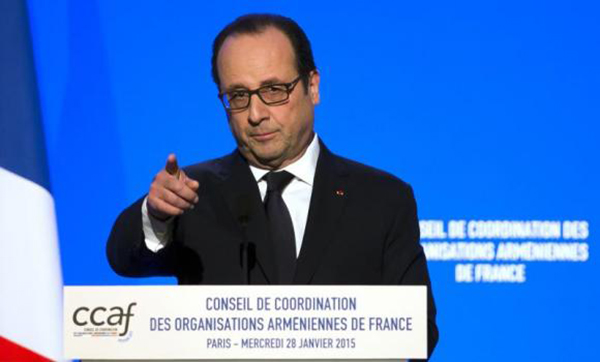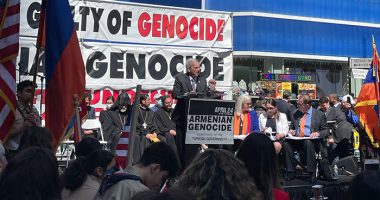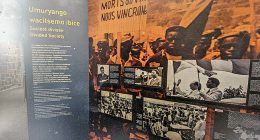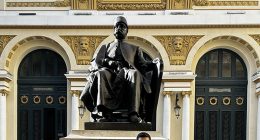WASHINGTON, DC – The Armenian National Institute (ANI), Armenian Genocide Museum of America (AGMA), and Armenian Assembly of America (Assembly) announced the launch of a fourth digital exhibit entitled ‘Iconic Images of the Armenian Genocide’ that brings together as a single collection key images recording the brutal mistreatment of the Armenian population of the Ottoman Empire and the utter destruction of their historic communities. The exhibit is designed to serve as an easily accessible educational tool that can be displayed in the classroom in digital or print format.
As more and more photographs of the Armenian Genocide are uncovered, and as the ‘Iconic Images’ exhibit illustrates, the general outline of the main events that defined the genocide can now be illustrated with compelling and dramatic images that survive from that era. Many of the images were taken in the teeth of a strictly enforced ban on photography by the Ottoman authorities. Other photographs capture the aftermath of the atrocities as witnessed by third parties.
Many invaluable pictures were destroyed during the war years and what remain are today scattered across continents. In view of how much was lost, these photographs are also survivors, many waiting for the time when they would be identified and reconnected to the events to which they attest.
These scattered images are now gathered and organized into a narrative exhibit that reconstructs many episodes of the Armenian Genocide. Together they recreate a sense of the terror exercised by the Young Turk regime and reveal the extent of the dispossession and decimation of the Armenian people in their historic homeland.
The photographs were collected from numerous repositories, sources and individuals, including the US National Archives, Library of Congress, Near East Foundation, Oberlin College Archives, ![]()
![]()
“The exhibit creates a panoramic view of the entire duration of the Armenian Genocide,” stated ANI Director Dr. Rouben Adalian. “All facets of the genocide that the photographic record allows, ranging from the deportations, executions, massacres, murders, starvation, extermination and destruction, are reconstructed panel by panel.”
“The exhibit also documents the immediate aftermath of the atrocities, attesting to the catastrophic ruination of Armenian society in the Ottoman Turkish Empire,” added Dr. Adalian. “With panels displaying photographs of survivors, rescued women, homeless children and refugees, the scale and depth of the uprooting of the Armenian people is revealed.”
Among the iconic images are also the rare pictures of concentration camps where deportation and extermination became synonymous. The postwar refugee camps where survivors gathered are hauntingly reminiscent in appearance of these concentration camps. In the refugee camps, however, located beyond the borders of modern-day Turkey, a generation of Armenians scarred by the atrocities began life anew in exile, making their locations the beginning points of the Armenian Diaspora.
The exhibit recalls as well the humanitarian activities of American philanthropists who organized critically needed relief, especially on behalf of the tens of thousands of orphans who were gathered, housed, fed, and educated in orphanages operated by the Congressionally-chartered Near East Relief organization.
![]()
![]()
The exhibit concludes with prominent memorials to the Armenian Genocide as a reflection of the commitment of the Armenian people the world over to remember and honor the victims of genocide. Concluding the exhibit are pictures of the memorial chapel of Der Zor, in present-day Syria, before and after its destruction, as a reminder that the legacy of the Armenian Genocide remains unresolved and continues to be violently challenged.
“With a symbolic 100 images in all, across 20 panels, and a map, ‘Iconic Images of the Armenian Genocide’ illustrates the scale of the Young Turk program to eradicate the Armenian people from its homeland, while reconstructing the multiple facets and lasting consequences of the deportation, massacre, and exile of the Armenians,” continued Dr. Adalian.
“By gathering and organizing these key photographs a comprehensive picture of the Armenian Genocide has been reconstructed,” said Adalian, “that will serve educators as an instructional guide for teaching about human rights and the consequences of their violation as applied to an entire people in the form of genocide.”
“The exhibit,” stated ANI Chairman Van Z. Krikorian, “was created to honor the exemplary figures in the United States diplomatic service whose conscientious reporting remains a permanent testament to the horrors of the Armenian Genocide, among them Jesse B. Jackson, US Consul in Aleppo; Leslie A. Davis, US Consul in Harput; Oscar Heizer, US Consul in Trebizond; George Horton, Consul-General in Smyrna; and in Constantinople, Gabriel Bie Ravndal, Consul-General; Hoffman Philip, Chargé d’Affaires; Abraham I. Elkus, Ambassador; and Henry Morgenthau, Ambassador.”
“The response to the prior exhibits has been greatly encouraging, and their widespread use is exactly what we intended by making these materials accessible for free,” Krikorian said. “We are pleased to add this latest installment to the series. I especially commend the staff of the Armenian National Institute and the Armenian Assembly of America, in particular Dr. Adalian, Joseph Piatt, and Aline Maksoudian,” concluded Krikorian.
‘Iconic Images of the Armenian Genocide,‘ is the fourth in a series of online exhibits released jointly by ANI, AGMA, and the Assembly and issued for worldwide distribution free of charge.









